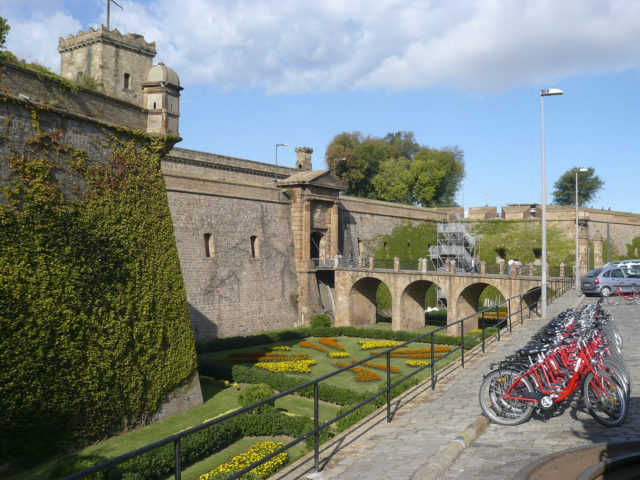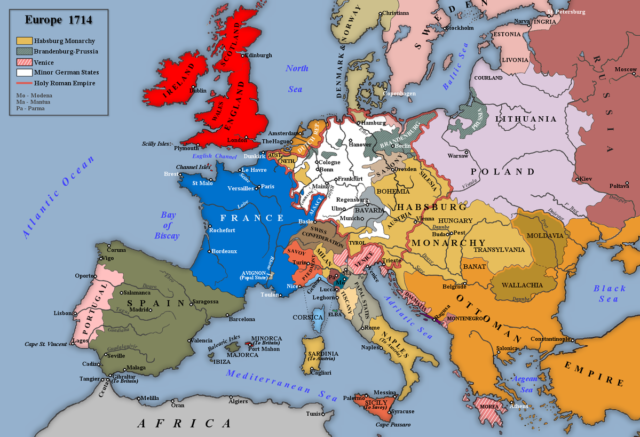Grown Up
Catalonia and Barcelona were not used to being on the sideline and were foreign to religious oppression practiced by the crown in the name of Catholicism. The anti-royalist sentiment started to take form at the beginning of the 16th century but the flames of dissent were to a great extent fanned during the 30 Years’ War of Religion (1618-1648).
In the Guerra de Segadors (Reapers’ War 1640-1652) the people of Cataluña rebelled against the power of King Felipe IV (who ascended the throne in 1621) opposed to the constant battles between Spain & France, to the presence of Castilian troops in Catalonia and the over-exploitation of Catalan resources by the Royal army.
On Corpus Christi day of May 1640 in Barcelona, the uprising known as ‘Bloody Corpus’ (Catalan: Corpus de Sang), would lead to the death of the Spanish Viceroy of Catalonia Dalmau de Queralt, Count of Santa Coloma. The irregular Catalan militia involved were known as the ‘Miquelets’.



Pau Claris, a Catalan lawyer, clergyman, and President of the Generalitat of Catalonia (the governing body of the city during the revolt) grabbed the chance and declared the creation of an independent Catalan Republic (January 23, 1641). Although the Spanish crown and army were preoccupied with the wars against the Protestants and were caught by surprise it quickly responded by sending an army of 26.000 strong headed by Pedro III Fajardo to crush the revolt.
Many cities were reconquered and hundreds of captured Catalans were executed in a matter of days, pouring even more fuel to the fire. In the Battle of Montjuic (January 26, 1641), defending their newbuilt castle on the hill, the Catalans achieved their first victory and things seemed to change for the better.
The death of Pau Claris a few days later and the need for military support would force the Catalans to seek an alliance with the French King (the historic ties were still strong). Louis XIII of France was proclaimed the sovereign count of Barcelona as Lluís I de Barcelona. For the next decade, the Catalans and French would fight as allies against the Spanish crown.



The military successes of the Franco- Catalan army would last until 1652 when the capital finally fell to the Spanish army after a siege that cut off Barcelona from the rest of the world from July 1651 to October 1652. King Louis XIII of France was forced to sign the Treaty of the Pyrenees that handed over Cataluña back to Felipe IV except for its northeast corner which was ceded to France.


Right before his death, with all potential Hapsburg successors having died before him, the childless Spanish King Charles II names the Bourbon Philip, Duke of Anjou as his successor in the year 1700. The last Hapsburg King of Spain was related to Philip of Anjou through the grandson of his sister Maria Theresa of Spain.
The far-fetched choice provoked the reaction of a Grand Alliance of powers (England, Portugal, Austria, Holy Roman Empire, Dutch Republic & others), all of which wanted to prevent a dynastic unification of the Spanish and the French kingdoms. In the so-called War of the Spanish Succession (1701-1713) Barcelona decided to support the claims of the Hapsburg Archduke Charles, favorite of the Great Alliance against the Bourbon Duke Philip of Anjou.


During the first four years of the war, Barcelona was in the hands of the Bourbons of Madrid despite the Catalans’ preference. In 1704 we have the first coming of the Allies in Barcelona after the contacts of several Catalan nobles with the English. Their hope for a resurgence of the people of Barcelona in support of the Allied fleet however did not fulfill itself.
A year later (1705) the multinational army of about 11.000 strong, led by the English nobleman Earl of Peterborough manages to take control of the city after conquering the Castle of Montjuic. A year later another siege would take place, this time by the Bourbons, who tried to recapture the Catalan capital without any success. Finally after a series of military victories by the Bourbons (Franco-Spanish) in 1709 and 1710 a truce is signed between France & England in 1711 which secures that the French and Spanish crowns will remain separate, in essence ending the Hapsburgs’ hopes for the Spanish throne.
For the Catalans however, nothing was over. They saw the Bourbon model of governance as exceedingly autocratic and opted for the Holy Roman Emperor Charles VI, as their preferred ruler. In the last and longest siege of the war (July 1713 – 11 September 1714), the Bourbon army of Philip V of Spain backed by France, managed to recapture Barcelona ending the long-held Catalan hopes for autonomy. September 11th is still celebrated today as the National day of Catalunya (La Diada).


The Bourbon King Felipe V punished the Catalans by outlawing their language, closing all universities, destroying a large section of the city & building a large fortress called La Ciudadela the largest fortress in Europe at the time with enough buildings to house up to 8,000 people. For its construction, more than 1200 houses in what is Barri de la Ribera today were demolished and 4,500 people were left homeless without compensation.
At the same time, the Castle of Montjuic would be completely remodeled to its current form to serve the new needs. The Treaty of Utrecht in 1713 and of Rastatt in 1714 ended the War of Spanish Succession and recognized Philip as King Felipe V of Spain. Most of the European territories possessed by Spain were lost as a consequence of the war.


The last of the Nueva Planta decrees, issued by the Bourbon King between 1706 & 1716 abolished Catalan autonomy completely putting an end to the year-long struggle for self-rule of the city of Barcelona. Despite the negative most of Catalan’s political developments, the city’s economy was in a cycle of growth since the end of the 17th century.
That growth was particularly evident in the explosive increase of its population, from about 30,000 at the beginning of the century to about 50,000 in 1760 and 95,000 in 1787. This recovery became most apparent after the authorization to trade directly with the Americas was given to the port of Barcelona in 1765.
With the city not being able to expand outwards due to its fortifications, the matter of housing became a mounting problem, leading to an increasing density of residents within the walls. Finally, in 1775 the city wall was demolished. La Rambla, previously situated on the outside of this wall, was transformed into a grand avenue. Very soon the landowners around the avenue opened up numerous new streets connecting their lots with the new avenue and turning La Rambla into a vibrant economic artery of the 19th century.


The full liberalization of overseas trade in 1778 and the peace treaty signed between Carlos III & the Sultan of the Ottoman Empire Abdul Hamid I in 1785, making trade transactions with the Far East possible, reopened Barcelona’s port to the world. By 1787 the Catalan urban density was the highest in Spain after Madrid.
By the end of the 18th century, the population had tripled from less than 40,000 to 130,000. Alas, the time of peace wouldn’t last for long. In 1793 Spain went to war with the Revolutionary French Republic. The war would lead to a 5-year occupation of Barcelona by the Napoleonic troops & a devastating war of independence that would last for 5 years (1808-1813) during which the Catalans gave their full support to the return of the House of Bourbon on the throne of Spain.
After the fall of the Bonapartist regime, the restored King Ferdinand VII was determined to rule as an absolute monarch, causing a series of conflicts between liberals & supporters of the traditional autocratic monarchy. Throughout the 19th century, there was a succession of constitutional periods followed by spasmodic revolutionary periods marked by the so-called Carlist Wars (1832-1839/1846-1849/ 1872-1876).
In the most outstanding event of that tumultuous period, the Catalan capital was indiscriminately bombarded by the army from Montjuic Castle in 1842 to suppress an insurgence by the workers and the bourgeoisie of Barcelona.




